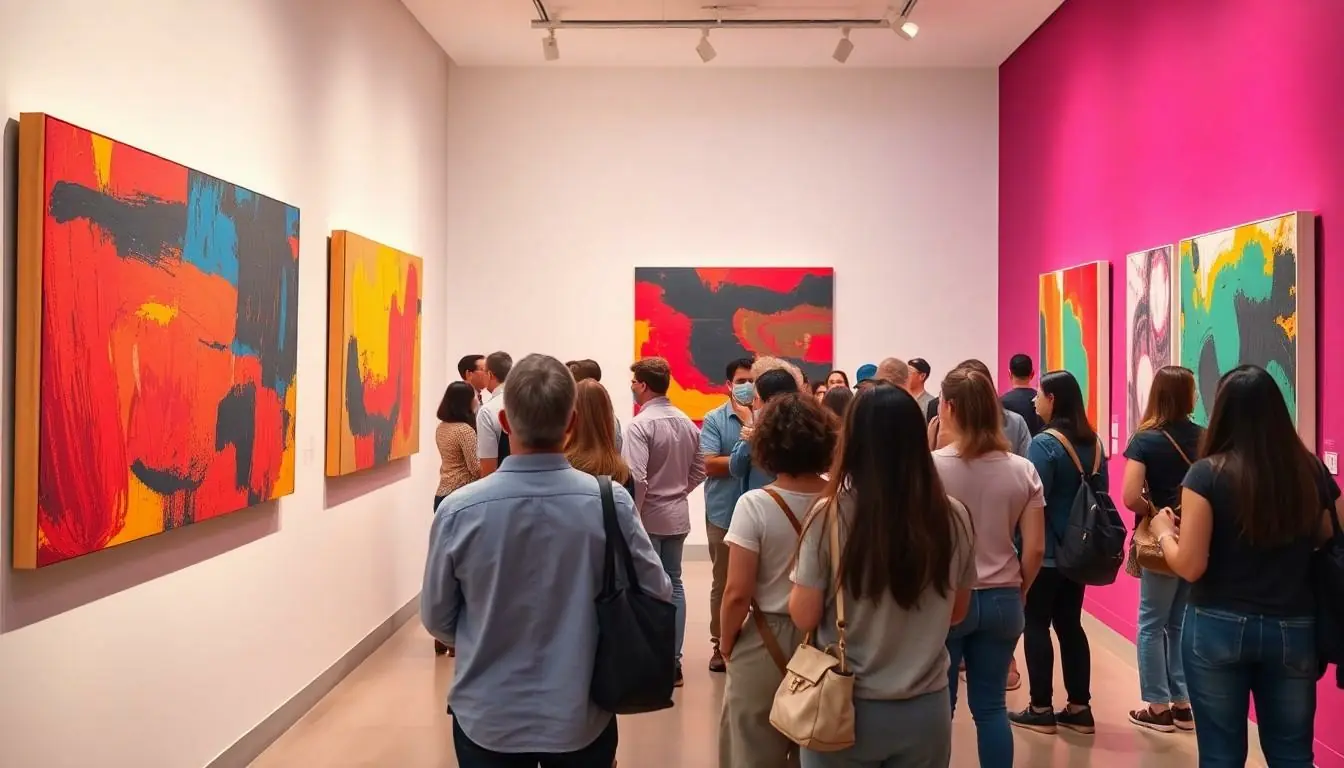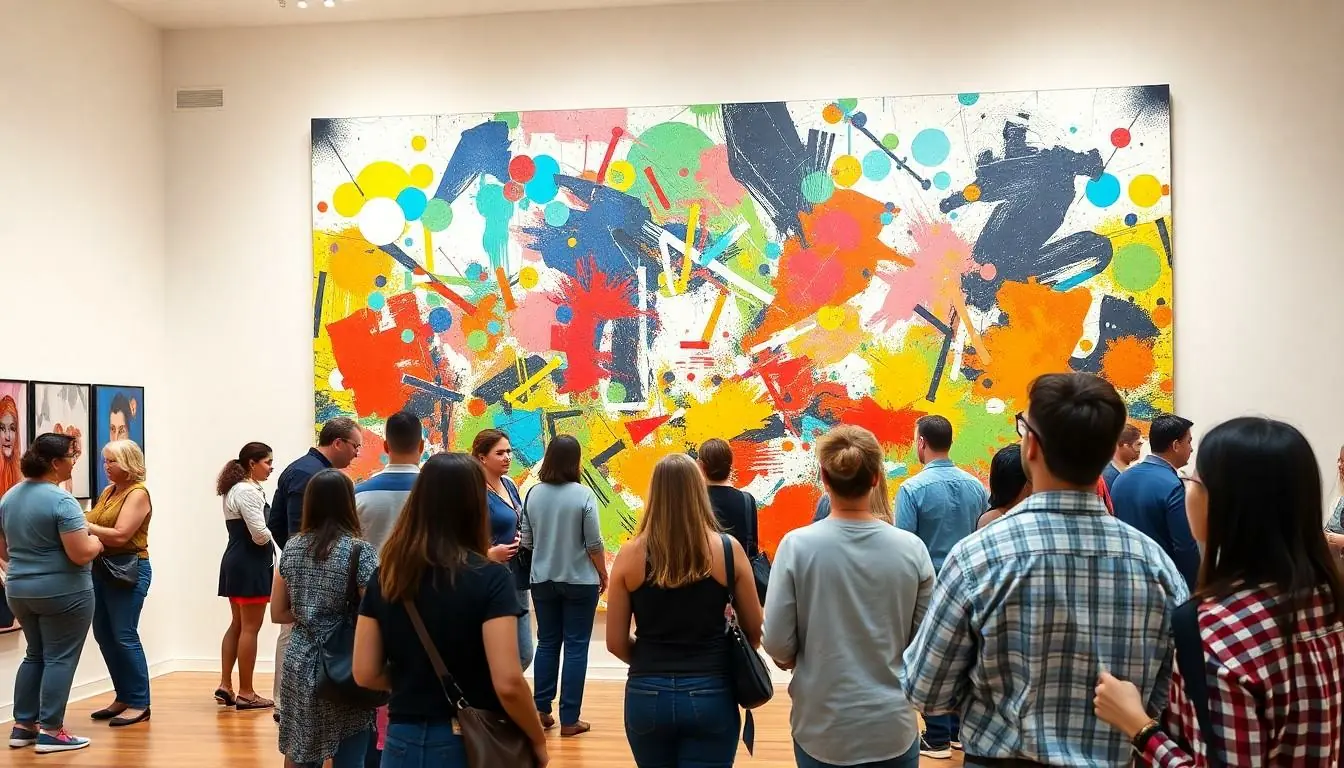Table of Contents
ToggleModern art isn’t just a splash of paint on a canvas; it’s a daring leap into the unknown. Artists have pushed boundaries, focusing on expression and innovation like never before. Forget the stuffy galleries of the past—today’s art invites everyone to dive into a world where emotions reign supreme and creativity knows no limits.
In this vibrant landscape, the emphasis lies on challenging perceptions and igniting conversations. Whether it’s through abstract shapes or bold colors, modern art dares viewers to see beyond the surface. So grab your beret and prepare to explore how these two elements intertwine, transforming art into a thrilling adventure that’s anything but ordinary.
The Evolution of Modern Art
Modern art evolved significantly throughout the late 19th and early 20th centuries. Artists began to reject traditional techniques, seeking new ways to depict reality. Expression emerged as a central theme, with artists channeling emotion through their work. Meanwhile, innovation became equally important, driving experimentation with materials and forms.
The Impressionists paved the way for abstraction by focusing on light and color rather than precise detail. Wassily Kandinsky further advanced these ideas, utilizing color to express deep emotions. Artists like Pablo Picasso challenged perspectives through Cubism, breaking objects into geometric forms. These essential shifts encouraged viewers to interpret art personally.
In the mid-20th century, movements such as Abstract Expressionism and Surrealism gained momentum. Artists such as Jackson Pollock employed spontaneous techniques, allowing emotions to shape their creations. Surrealists like Salvador Dalí explored dreams and unconscious thoughts, blurring the lines between reality and imagination. These movements encouraged the exploration of inner psyche and societal themes.
Contemporary art continues to reflect this legacy, with artists incorporating diverse media and themes. Photographers, sculptors, and digital artists now expand traditional definitions of art. Concepts such as identity, culture, and technology drive modern artistic discussions. The focus remains on evoking emotional responses and sparking dialogue among viewers.
Through its evolution, modern art has transformed the perception of creativity. It invites individuals to consider their interpretations and connections to the art world. Boundaries continue to shift, allowing for an increasingly inclusive landscape in artistic expression.
Key Concepts in Modern Art

Modern art revolutionizes how artists convey messages through individual expression and abstract forms.
Emphasis on Individual Expression
Individual expression takes center stage in modern art. Artists strive to showcase their unique perspectives and emotional experiences. Through vibrant colors and dynamic brushwork, they communicate personal narratives. Iconic figures like Vincent van Gogh exemplify this focus, using impassioned strokes that express deep feelings. This emphasis on individualism contrasts with traditional art, which often served to depict reality or idealized subjects. Each artist’s voice emerges distinctly in modern works, allowing viewers to engage with diverse emotions. The freedom to explore personal themes contributes greatly to the richness of modern art.
Emphasis on Abstract Forms
Abstract forms play a pivotal role in modern art. Artists experiment with shapes, colors, and textures to convey feelings beyond the representational. Wassily Kandinsky’s pioneering work exemplifies this as his compositions evoke emotion through non-representational elements. Similar experimentation leads to movements such as Cubism and Futurism, where familiar objects are deconstructed. Viewers experience a heightened sense of interpretation, with each abstract piece offering multiple meanings. The focus on abstraction shifts attention from the subject to the raw expression itself, breaking conventional artistic boundaries.
Influential Artists and Their Contributions
Modern art features numerous influential artists who reshaped artistic expression and innovation. These individuals challenged traditional norms, creating a profound impact on the art world.
Case Study: Artist A
Wassily Kandinsky played a pivotal role in the birth of abstract art. He believed that colors and shapes could evoke emotions without representing specific objects. Kandinsky’s use of vibrant hues and dynamic forms laid the groundwork for future abstract movements. His seminal work, “Composition VII,” exemplifies this philosophy, merging spiritual concepts with visual experience. An exploration of sound and color marked his approach, influencing generations of artists. Emerging from his ideas, Abstract Expressionism gained traction in the mid-20th century, impacting how viewers perceive emotional responses in visual art.
Case Study: Artist B
Pablo Picasso revolutionized the art world through Cubism, changing how reality could be depicted. He utilized geometric shapes to reconstruct subjects from multiple perspectives, inviting viewers to engage in new interpretations. In his famed piece, “Les Demoiselles d’Avignon,” Picasso broke traditional aesthetics, creating a dialogue about the nature of representation. His innovative techniques inspired countless artists to explore abstraction, leading to diverse movements in modern art. Picasso’s influence continues to resonate, encouraging experimentation with form and perspective in contemporary creations.
The Impact of Modern Art on Society
Modern art reshapes societal views through creative expression. Artists challenge traditional expectations, influencing the way communities perceive reality. Emotional engagement drives much of this impact, as viewers connect personally with pieces that reflect their experiences.
New movements redefine artistic engagement. Abstract Expressionism and Surrealism create dialogues about identity and the unconscious. Artists such as Jackson Pollock and Salvador Dalí encourage audiences to explore deeper meanings behind forms and colors. This exploration transforms mundane perceptions into profound interactions.
Cultural discussions emerge from modern art. Themes related to technology, identity, and social issues invite conversations among diverse audiences. By representing various perspectives, modern art fosters inclusivity and broadens the reach of art beyond elite circles.
Artistic innovation contributes significantly to societal change. Iconic figures, like Vincent van Gogh and Pablo Picasso, alter the landscape of visual communication. Their unique approaches help individuals rethink traditional narratives, emphasizing personal expression and emotional depth.
Engagement becomes a vital aspect of the modern art experience. Through interactive exhibitions and immersive installations, viewers participate actively rather than passively observing. This shift enhances understanding and appreciation, leading to a more profound relationship between the audience and the artwork.
Ultimately, modern art cultivates critical thinking and emotional resonance. It encourages individuals to question established norms and embrace alternative viewpoints. Society benefits by welcoming diverse expressions and redefining the role of art in daily life.
Modern art’s emphasis on individual expression and abstract forms has revolutionized the way people engage with creativity. By prioritizing emotional resonance and innovative techniques, artists have created a dynamic landscape that invites viewers to explore diverse interpretations. This shift not only challenges traditional perceptions but also encourages a deeper connection between art and society.
As modern art continues to evolve, it remains a powerful medium for dialogue and reflection. The focus on personal narratives and emotional depth fosters an inclusive environment where everyone can participate in the artistic experience. Ultimately, modern art transcends mere aesthetics, becoming a vital force for cultural change and understanding in today’s world.






